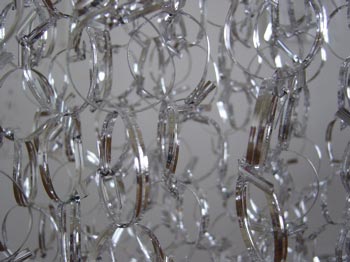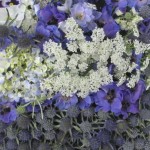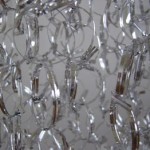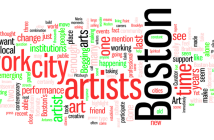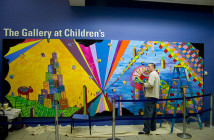Note: This piece is the third and final of a series of interviews by Christian Holland with the four 2006 finalists for the ICA's James and Audrey Foster prize. Previously he interviewed finalists Kelly Sherman and Jane D. Marsching.
Christian Holland: What would the ICA mean for you both as Artists? Or as individuals?
Rachel Perry Welty: I haven't gone there. I'm just trying to get the show up and make the best show that I can and that really is what I've been totally focused on.
CH: When you found out about it what were your first thoughts?
RPW: I was thrilled. I was shocked and very excited. Right away I started thinking about work to put in the show.
CH: Who'd you call first when you found out you were a finalist?
RPW: Nobody...
Sheila Gallagher: We were sworn to secrecy.
RPW: My son was with me when I got the call, and I was actually at the Museum of Fine Arts fixing a sculpture, and he said, "What happened?! What happened?!" and I said, "Oh, nothing, it's just about art." (laughs)
CH: What about you, Sheila, what would the prize mean for you?
SG: Um... I'd pay off my home equity loan and stop selling my furniture (laughs). And it would just be terrific validation.
No, I was totally surprised when I first heard. I was completely shocked. But it also made me realize—because lots of times when you don't get things, you think, "Oh, I'm really hurt"—now I realize actually how random it is.
First I was really excited, then throughout the entire summer, I think I was deeply embarrassed, because I have so many great artist friends, peers and mentors in Boston who I know have work just as good as mine and could easily be a finalist. So it was kind of mortifying.
RPW: There are so many deserving artists in this town.
CH: When other artists found out about you being a finalist, did they congratulate you?
SG: Yes, absolutely.
RPW: We all knew individually, who was a finalist, but we had no idea who the other three were.
SG: So it was really fun; Rachel and I have been in a critique group together for ten years, and Jane [Marsching] and I are really close friends so it was really fun.
CH: When I spoke with Jane Marsching we talked about some of the previous artists who have received the award and how, when they won, it was at a period of their career when they were transitioning from so-called mid-career artists to a much greater stage within the art world. Do you see yourselves as being at that point?
SG: Rachel's already a jetsetter (laughs)
RPW: No more than you, Sheila.
SG: I think it would be really nice, for me, if I could transition out of Boston, because I feel like I've done one good show after another for many years, I teach and I have a child; and it's just really hard to break out of regionality. So, I see this is as a great opportunity; the art world is coming to us, so we don't have to go schlep our slides around Chelsea.
And I don't know how many people they're expecting in the first week, but the scale of the audience...
RPW: I think there was something like 44,000 people that came through the Traveling Scholars [at the MFA]show and that’s probably small compared to what there will be here.
CH: Do you agree with Sheila that you'll no longer need to take your slides down to Chelsea?
SG: I don't know if, "no longer," but they are coming to you rather than you going there.
RPW: I think it's great that so many people are coming to see the exhibit. It's a pilgrimage for many just to see the building.
CH: What does it do for you to be an artist in Boston? Do you think it's a good launch-pad?
SG: I actually think Boston's a great place to make work, because there are so few other distractions -— there's very few places I'd rather be than my studio. And I think there's an incredible community of artists here. I have a lot of artist friends in New York —- people I went to Graduate School with -— but I have this amazing group: Rachel, Jane, Deb Todd Wheeler, Cristi Rinklin. It's not a competitive place -— a lot of my friends in New York are much more competitive with each other in terms of their careers. I think Boston is a great clean place to make work, and because there's so little commerce, the work gets to be a lot more about ideas than in some other places.
RPW: There are few distractions, but there's an incredible wealth of intellectual opportunity because of all the colleges and universities. Any night of the week you can go see a lecture somewhere.
SG: Yeah, you can have a great art education and never be enrolled anywhere.
CH: Do you think Boston is artistically competitive?
SG: I don't think Boston is artistically competitive at all. I think it is a positive love fest here with other artists. (to Welty) Do you think it's competitive?
RPW: I don't feel like I have my finger on the pulse of that. I've lived all over the world, but I haven't made art -— I haven't done the New York thing.
SG: (to Welty): And you have a long collaborative relationship with your mother.
RPW: Yeah, that's true.
SG: There's lot's of collaboration going on. People are constantly making studio visits, and everybody's work is so different. It's like when I tell my students, "You're a daisy, and a rose is good, and a daisy is good, and a carnation is good. They're all different flowers and they all have different functions (laughs) I think artists in Boston basically feel that way.
CH: After now, after being a finalist, after having a show in the ICA, a lot more attention is going to come your way. I know Kelly [Sherman] is moving to New York. Jane said she's staying. Do either of you foresee yourselves staying here?
RPW: I'm staying...
SG: Do you have a fantasy of moving somewhere else?
RPW: ...But never say never. (laughs)
SG: (to Welty): I could see you doing Asia.
RPW: I think we’ll be staying here. I have a son who is in school here, and my husband has a business here.
I think many artists don’t even need a studio. I’m not a painter, so I don’t make a huge mess. I have a studio, but I end up working mostly in my kitchen, living room and bedroom. And with the internet, I don’t know that where you live is as important. I try to get to New York once a month—see people and see shows. I travel a lot and I think that’s a good way to keep informed.
CH: What about your work do you think garnered you a place amongst the finalists for the ICA prize?
SG: Can Rachel answer that question first? (laughs)
Well, I already said I think it's a little bit random because I think it could have been about 30 people that I can name off the top of my head. I suspect, and I did hear this, that some members of the jury were interested in how every project I did was different -— I took a single idea and walked around in a variety of media. You look at [the show in the ICA]and you would not know that it was the same person that did Séance last year. There are similar ways of working, but none of the work looks like any other work.
SG: (to Gallagher): Well, I do see a thread, but different projects.
SG: But to answer your question, I have no idea.
RPW: That's my answer too. I have no idea. There are so many artists out there working so hard and showing and achieving great success.
CH: So modest.
SG: It's a pretty modest group.
CH: What do you both think about all of the artists being women?
RPW: I think it's great, but I don't know why...
SG: I think it's interesting that it's all women.
Most of my artist friends in Boston, of my generation, are women. Most of my teaching colleagues are male artists of an older generation. It is the same at the Art Institute of Boston; I teach at Boston College now, and a lot of the painting department at theMuseum School was men of a previous generation. (to Perry Welty:) Do we have any men in our crit group?
RPW: No...
CH: Who is in your crit group?
SG: Rachel, Rachel's mom...
RPW: Sarah Hollis Perry, Cristi Rinklin, Shannon Curry Green -— she moved to New York, Bethany Bristow -— she moved to New York...
SG: And we've had other people come in and out.
RPW: Mira Cantor, Kali, who moved to Otis in California for a teaching job.
SG: ...and Maureen Coffey whose now become more of a poet and writer but we still get together and talk about art.
CH: So, previous winners of the ICA prize. Are there prize winners that you admire? How do you think your work compares to theirs?
RPW: There are some wonderful artists who have won; I don't know them all...
SG: Layla Ali was the first winner?
RPW: No, Ambreen [Butt]
SG: I remember seeing Ali's work at Miller Block at her first show here. And thinking, "That is great work..."
RPW: Yeah! I do too.
SG: ...I would like one of those, I want to buy one of those.
But Kanishka [Raja], Taylor [Davis], Douglas Weathersby...
RPW: ...Alice [Swinden] Carter...
SG: I feel like we're In good company. But I like this set-up; I think this is much more exciting than just bestowing a prize.
CH: It seems that just being a finalist puts you league with the previous winners.
SG: I've been to the Hugo Boss competition and the Turner Prize exhibition, and I actually cannot tell you anyone who won...
RPW: Because you just remember the show.
SG: Did Tracy Emin win that year or did Isaac Julien win that year? I have no idea, but I think they are really great shows. One of the things that interests me about those shows is how diverse the work is, and I have to think that one of the things that came into play with this jury is that they didn't want people whose work was too close to each other.
CH: As individuals you are diverse, however you are all making work that is diverse. Like you, Sheila, were saying before, you heard that the jury chose you because your work is so varied —- no two shows are alike -— but Jane and Kelly are like that as well. Do you, Rachel, think you could put yourself into that category?
RPW: Well I think that I work in a lot of different media; the idea comes first and the media is to fit what the concept is. But it's so much more common now for artists to do that and it's interesting that the four of us are each showing a video.
----
I spoke with Welty and Gallagher individually about their work. I began with Welty as she got into a Genie construction lift and rose 15 feet above the gallery floor to continue installing her piece, Wall (2006), which she created for the James and Audrey Foster prize finalists' exhibition.
RPW: I think you already know [Wall's] made out of 60,000 twist ties, and mimics the existing architecture in this gallery. This summer I gathered people from a posting on Craigslist, because I knew that there was no way I could physically make this sculpture myself. From the posting I got about 300 responses, and the list whittled itself down to about 43 people who were really dedicated. I went to meet the first person at 8:30 and I was going to meet the next one at 9:00 and the next at 9:30, but the person who came at 8:30 ended up staying until noon and second person stayed until noon, and so forth, so I came up with this idea of having twisting bees. So from 9:00 to noon, every Tuesday and Friday for four months we gathered at the same coffee shop in Cambridge, I bought everybody coffee, we talked about art and relationships, and roommates, and where to find a good used bike, and they helped me get this project together.
CH: What coffee shop was it?
RPW: It was Starbucks (laughs), which works perfectly with this, doesn't it? It says something about what Starbucks is in our culture, because I didn't know any of these people —- I was meeting strangers so I wanted to pick a safe spot and it just seemed like a natural location. So, it took a community to make this 21st century barn raising —- to make this wall. Each fifteen foot strand has 142 to 145 twist ties.
CH: Did you get the dimensions of the gallery walls before set out to create Wall?
RPW: Yes, it was the first thing I asked.
CH: What about the twist tie piece, two page spread, installed on the wall here?
RPW: That's a project that I started in art school. I've been collecting twist ties from anyone who's been willing to give me a bit of their kitchen. I just started stringing them together and the next thing I knew I had a huge collection of them. It’s amazing in life what we don’t see – the difference between what we’re looking at and what we’re looking for.
CH: All together, how long is it?
RPW: I don't know. People always want to know, but I don't pay a lot of attention to the numbers, but I think it's about 3,000 feet long at this point.
CH: How does two page spread relate to Wall?
RPW: Well, Wall is an accretion in a different way, it's not a collection, but one piece to the next piece, to the next piece, makes it. It's also in the community that it took to build them; in different ways, though —- I actually do all the connecting in two page spread —- people do the scrounging and collecting for me. And in Wall, I buy them and have people put it together and all their stories are in it too —- as we sat and talked in the coffee shop.
CH: When you first started it, was the community aspect important?
RPW: No, I didn't know what was going to happen. I was blown away that people were curious and interested in helping and that I really relied on that to make the work happen.
The piece behind you is called Food Pyramid and it's an inverted pyramid [of miniature replicas of food boxes installed on the wall] based on what we actually eat versus what we should eat. It's from my own family's consumption over the last couple of years.
CH: So it's actually empirical data?
RPW: Yes, and I think of that as being coded, like two page spread; it looks like a code or text. I take the actual containers, after we consume the contents, and I open up the boxes, photocopy and reduce them. I'm thinking a lot about this miniature inflaming the desire to acquire. They're made into something cute and precious or something that you want to buy.
And I’ll be showing the video I made called Karaoke Wrong Number which uses digital leftovers -- I saved the wrong number messages that came to our machine over the course of four years, and I lip-sync to them. It astonishes me how we are always just a hair’s breadth away from complete misunderstanding of one another.
----
After speaking with Welty, I walked over into Gallagher's section of the gallery where she was configuring the watering system of wall of floral foam for her piece, Cumulonimbus, a wall-sized, vertically installed, flower installation of clouds that she created for the James and Audrey Foster Prize finalists' exhibition.
SG: These things are always scary -— this is the fifth one I've done —- because it's approximately 500 gallons of water running [through the wall]in the new ICA. Each one of these blocks [of floral foam], when fully soaked, weighs four to six pounds. If you just figure about pound per gallon . It's a lot of water, so you have to be incredibly careful.
My exhibition is called "UNKNOWN SOURCE" and it is conceived as an artistic and spiritual scavenger hunt where you take clues from all of the work and hopefully they work together to express a single phnemonenon. The idea being that the medium of video communicates one way, flower installations function in another manner, and the smoke paintings and sound piece do other things.
CH: How are you going to install flowers into the wall of foam?
SG: I cut all the flowers to four and a half inches and go up in a Genie lift and stick them in. Really, it's just creating a painting with flowers. So it's a lot of checking value and trying to get the exact color. It's very pointillist; it's a lot of optical mixing where you're just sticking one color next to another and hoping that the general effect creates an illusion.
All of the the work is loosely inspired by a 14th century Christian mystical text called The Cloud of Unknowing which is the first mystical text written in the English language. "UNKNOWN SOURCE" refers to both the anonymous author of the Cloud of Unknowing as well as the art historical precedents which are referenced in the various works. It was written by anonymous so a lot of the work is therefore "UNKNOWN SOURCE".
The paintings are based on Frederick Church. I say "after Church," but "their" switch to they are based very closely on his compositions.
CH: They are done with smoke?
SG: They are completely made out of smoke, where I suspend the canvases from a pulley system on the ceiling and then I use different smoking implements to create different mark making systems. In certain places to get detail I cut out little pieces of tape or a metal stencil. They are the hardest things I've ever done. You have to completely emotionally have your act together because you get one try, you have to be fast and you can't erase because once [the soot]is down it's down.
I do find something redeeming about beauty so I definitely wanted the worked work to be beautiful. My mother asked me, "Why don't you just paint it?!" Because I feel like you can't paint like Frederick Church in 2006. We can't have that kind of naivete about the American landscape that we do now. It's a contaminated love affair that we have with it so I wanted the material to reflect that but to still be tinged with this beauty.
One of the things I was looking at was drawing parallels between the desire for spiritual experience and experiencing nature. How do we even deal with the idea of the sublime vis-à-vis the America landscape in 2006? As I look around the work, I hope it's beautiful, but it's also tinged with this potential violence or almost funereal aspect —- all these things being ephemeral materials.
The video, Equivalence, is a cycle and it shows people searching for things they cannot see. It shows people praying and dowsing for water. It incorporates all the other imagery of the show.
Part of what I'm looking at with this work is that you can't show people dowsing, you can't show people praying. You can show images of them doing it, but those are really invisible activities, as is a search for a spiritual or sublime experience. All we really have are these models. So these are all about the limitations of representation, but I'm still taking stab at it.
Links:
Institute of Contemporary Art
"The James and Audrey Foster Prize" is on view December 10, 2006 - March 11, 2007 at The Institute of Contemporary Art.
All images are courtesy of the artists and the ICA. Perry Welty image also courtesy of Barbara Krakow Gallery.

